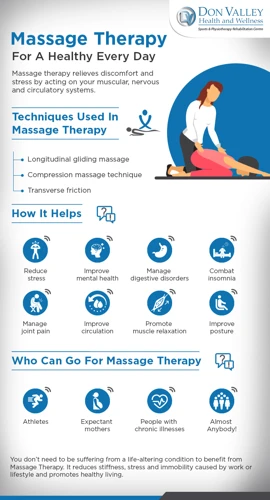The main benefit of therapeutic massage is its healing power. Therapeutic massage has been used for thousands of years to aid in healing and provide relief from pain and stress. It can help improve circulation, reduce tension, and promote relaxation. By decreasing muscle tension, therapeutic massage can also help reduce inflammation, improve joint mobility, and increase range of motion. Therapeutic massage can also help to improve mental health and reduce stress levels.
Contents
Definition of Therapeutic Massage
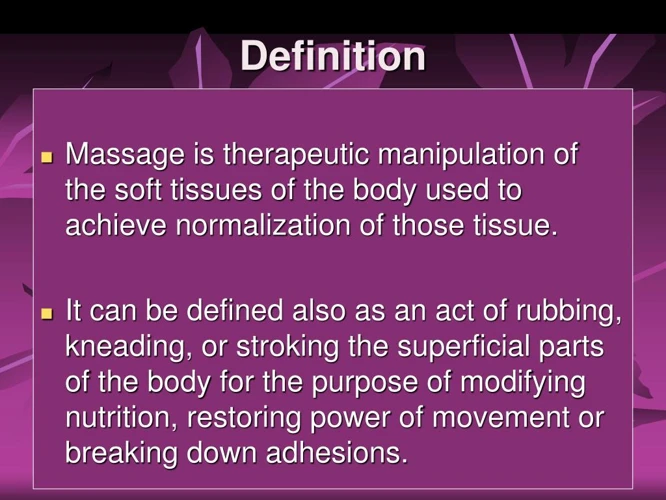
Therapeutic massage is a type of massage therapy that focuses on relieving tension and pain in the body. It is used to treat a variety of ailments and health conditions, such as muscle tension, joint pain, and stress-related conditions. It is done by applying pressure to the affected area, often with the use of massage oils, lotions, or creams.
- It is a holistic approach: Therapeutic massage is an holistic approach to health and wellness that takes into account the physical, mental, emotional, and spiritual aspects of the body. This helps to create balance and harmony in the body and mind, which can promote healing and overall wellbeing.
- It helps to reduce stress: Stress can have a negative impact on the body and mind, leading to physical and emotional problems. Therapeutic massage can help reduce stress levels and promote relaxation, which can help to improve overall health and wellbeing.
- It helps to relieve pain: Therapeutic massage can help to reduce pain and soreness in the body, particularly in the neck and shoulders, as well as in the back and legs. It can also help to reduce inflammation and swelling in the affected area, which can lead to improved mobility and range of motion.
- It can improve circulation: Therapeutic massage can help to improve circulation, which can help to increase oxygen and nutrient levels in the body. Improved circulation can also help to reduce fatigue and improve overall energy levels.
- It can improve mood and mental health: Therapeutic massage can help to improve mood and reduce anxiety and depression. It can also help to reduce stress and tension, which can help to improve overall mental health and wellbeing.
The main benefit of therapeutic massage is that it can provide relief from pain, improve circulation, reduce stress, and improve overall wellbeing. It is an holistic approach to health and wellness that can help to promote healing and improve quality of life.
Benefits of Therapeutic Massage
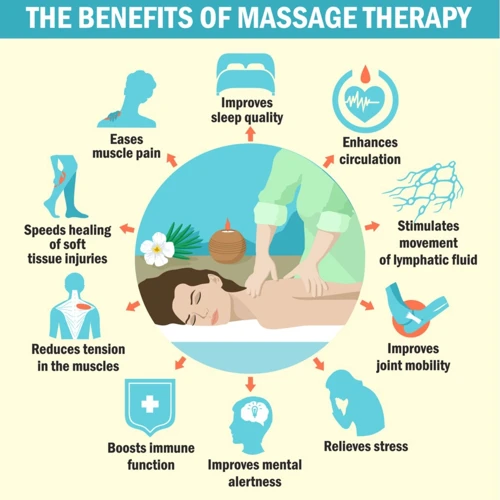
Physiological Benefits
Therapeutic massage can have a positive impact on the body’s physiological functioning. It can reduce pain, improve circulation, reduce muscular tension, and improve flexibility. Massage can also help to lower blood pressure and improve the body’s immune system.
Psychological Benefits
Therapeutic massage can also have a positive effect on the mind, helping to reduce stress, improve mood, and provide a sense of relaxation and well-being. Massage can also help to reduce anxiety, improve sleep, and promote a sense of calm.
Types of Therapeutic Massage
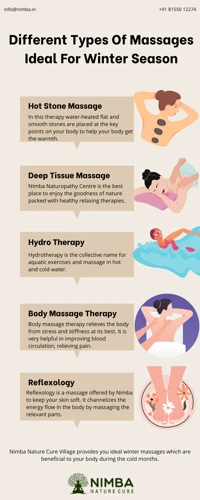
Swedish Massage
Swedish massage is the most popular type of massage. It uses long strokes, kneading, and friction techniques on the more superficial layers of muscles, to promote relaxation and improve circulation.
Deep Tissue Massage
Deep tissue massage is used to target the deeper layers of muscle and connective tissue. It is used to help with chronic muscular pain, injury rehabilitation, and reduce inflammation-related pain caused by arthritis and tendinitis.
Trigger Point Massage
Trigger point massage is used to relieve pain in specific areas of the body by targeting “trigger points” or tight areas within the muscle tissue. This massage technique is often used to treat myofascial pain, fibromyalgia, and other chronic conditions.
Sports Massage
Sports massage is designed to prepare athletes for their best performance, reduce fatigue, and relieve muscle swelling and tension. It can also be used to treat injuries, improve flexibility and range of motion, and improve recovery time.
The main benefit of therapeutic massage is that it helps to relieve muscular tension, improve circulation, and reduce stress. Massage therapy can be used to treat a wide range of conditions, from chronic pain to anxiety and depression. Massage is also beneficial for the immune system, as it can help to reduce inflammation and improve the body’s ability to fight off infection.
Contraindications
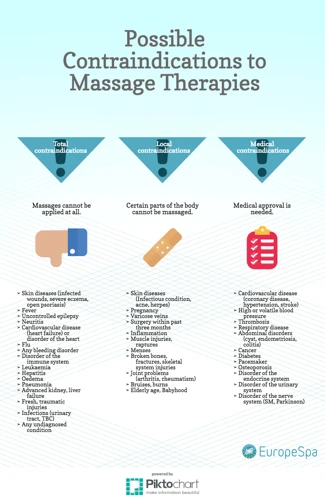
Therapeutic massage is not suitable for everyone and can be dangerous in certain cases. The following conditions are contraindications for massage therapy:
| Condition | Risk |
|---|---|
| Deep vein thrombosis | Massage can cause a clot to move and cause pulmonary embolism. |
| Bone fracture | The movement of massage can cause further damage to the fracture. |
| Cancer | Massage may cause the spread of cancer cells. |
| Varicose veins | Massage can cause the veins to swell. |
| Acute inflammation | Massage can worsen inflammation. |
| Infectious diseases | Massage can spread contagious diseases. |
| Heart disease | Massage can cause a sudden increase in heart rate. |
If any of the above conditions are present, massage therapy should be avoided. It is important to speak to a doctor before receiving massage therapy.
Preparation for a Massage
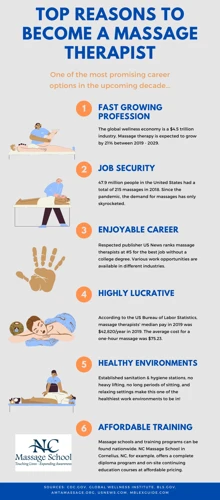
Prior to the massage, it is important to make sure the area being massaged is clean and free from clothing and jewelry. Ensure the massage table is comfortable and that the room is at a comfortable temperature. Be sure to drink plenty of water before the massage to stay hydrated and help flush out toxins released during the massage. If a massage oil or lotion is being used, it should be tested on a small area of skin prior to the massage.
During the massage, communicate if the pressure is too light or too hard, or if the massage needs to be stopped for any reason. Be sure to rest for a few minutes after the massage to let the body process all the energy that has been released.
Post massage, drink plenty of water and take a warm shower to help remove toxins that were released during the massage. Avoid strenuous activity for the rest of the day and allow the body some time to rest, relax and recuperate.
Precautions During a Massage

| Type of Massage | Precautions |
|---|---|
| Swedish Massage |
|
| Deep Tissue Massage |
|
| Sports Massage |
|
Before a massage, the massage therapist should discuss any health concerns with the client. People with certain medical conditions may need to take additional precautions. It is important to follow the massage therapist’s advice and take any necessary precautions.
Aftercare
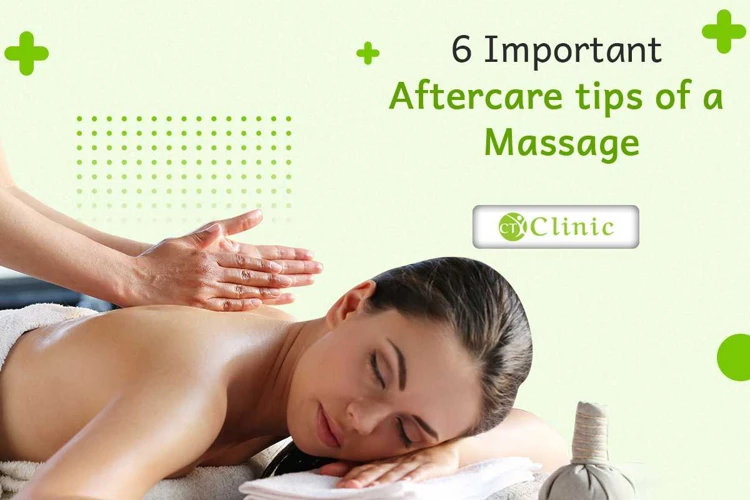
After a therapeutic massage, it is important to drink plenty of water to help flush out toxins released during the massage, and to allow the body to continue to heal. It is also recommended to take it easy and to avoid strenuous activities for the remainder of the day. An ice pack can be applied to sore areas, and heat can be used to alleviate stiffness in the muscles. If needed, over-the-counter pain medications can be taken, but it is important to consult with a physician before taking any medications. Additionally, stretching and light exercise can help reduce muscle tightness, and help the body to heal.
Cost of Therapeutic Massage
The cost of therapeutic massage varies depending on the type of massage and the length of the session. A typical one-hour massage can range from $50 to $200, depending on the therapist’s experience and the area in which you live. Generally, the longer the session, the higher the cost. For example, a one-hour deep tissue massage may cost $90, while a two-hour session may cost up to $250.
| Type of Massage | Cost/Hour |
|---|---|
| Swedish Massage | $50-150 |
| Deep Tissue Massage | $90-250 |
| Prenatal Massage | $75-150 |
| Sports Massage | $90-250 |
| Hot Stone Massage | $90-250 |
It is important to keep in mind that the cost of therapeutic massage is just one factor to consider when deciding if massage is right for you. Research has shown that massage can provide many health benefits, such as reducing stress, relieving pain, and improving sleep. While the cost of a massage may be an initial investment, the benefits that come with it may be priceless.
Frequently Asked Questions
What techniques are used in Therapeutic Massage?
Swedish Massage: This is the most common type of massage and is used to promote relaxation and loosen tight muscles. It involves long, gentle strokes, kneading, and friction techniques on the top layers of muscles.
Deep Tissue Massage: This type of massage targets the deeper layers of muscle and connective tissue. It is used to relieve chronic tension and pain, and to release muscle “knots” or adhesions.
Trigger Point Massage: This technique involves applying pressure to specific areas of the body that have tight muscle fibers, known as “trigger points.” This can help reduce chronic pain.
Sports Massage: This type of massage is used to help athletes prepare for and recover from athletic events. It can help improve performance, reduce recovery time, and prevent injuries.
Reflexology: This type of massage involves applying pressure to the feet, hands, and ears. It is based on the belief that these areas of the body correspond with other organs and systems in the body.
Shiatsu Massage: This type of massage is based on traditional Chinese medicine and involves applying pressure to specific points on the body. It is used to stimulate circulation, restore energy balance, and reduce stress.
How can Therapeutic Massage help with stress and anxiety?
- Reduce stress hormones. Therapeutic massage can help reduce cortisol and other stress hormones in the body, helping to improve overall stress and anxiety levels.
- Increase relaxation. Massage can be incredibly relaxing, helping to reduce tension and promote a sense of calm and wellbeing.
- Reduce physical tension. Therapeutic massage can help to loosen tight muscles and reduce physical tension, which can be a major contributor to stress and anxiety.
- Improve sleep. Massage can help to improve sleep quality and duration, which is important for managing stress and anxiety levels.
- Improve mood. Massage can help to boost serotonin levels, which can have an overall positive effect on mood.
What are the Potential Risks of Therapeutic Massage?
- Infection: If the massage therapist does not maintain proper hygiene, it can lead to infection.
- Muscle Injury: If the massage therapist is too aggressive, the massage can cause muscle injury.
- Tissue Damage: Inadequate pressure during massage can cause tissue damage.
- Nerve Injury: If the massage therapist applies too much pressure, it can damage a nerve.
- Blood Clots: Massage can cause blood clots in certain individuals.
- Allergic Reactions: Those with sensitive skin may have an allergic reaction to the massage oil.
How Often Should One Receive Therapeutic Massage?
Therapeutic massage frequency varies from person to person. Those dealing with chronic pain and stress may benefit from receiving massage treatments more frequently, such as once or twice a week. Others may only need a massage once a month or less. It is important to consult with a massage therapist to determine the best frequency for you.
Are there any contraindications to receiving Therapeutic Massage?
- Infectious Diseases: Massage should not be given to someone with an infectious skin condition or an acute infectious disease.
- Skin Disorders: Massage should not be given over areas of skin inflammation, rash, or open wounds.
- Cancer: Massage should not be given to someone with an active cancer or cancer treatments.
- Fractures: Massage should not be given over a fracture or recent injury.
- High Blood Pressure: Massage should not be given to someone with uncontrolled high blood pressure.
- Pregnancy: Massage should not be given to a pregnant woman in her first trimester.
Contraindications are conditions, illnesses, or circumstances that make massage therapy inadvisable. It is important to make sure that the person receiving massage therapy is not at risk for any adverse reactions or complications. It is also important to get a health history and information about any medications being taken before providing massage therapy. Some contraindications to receiving therapeutic massage include: infectious diseases, skin disorders, cancer, fractures, high blood pressure, and pregnancy.
Conclusion
Therapeutic massage is a powerful form of healing that can provide physical, mental, and emotional benefits. It can help reduce stress, alleviate pain, improve circulation, and promote relaxation. Massage therapy can also help improve sleep, promote better posture, and reduce fatigue. With regular massage sessions, people can experience improved overall wellbeing.

